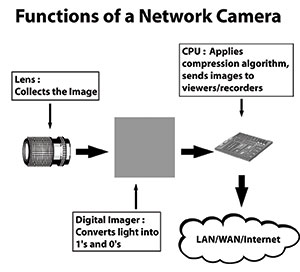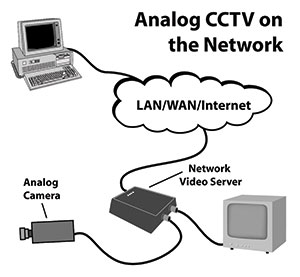When considering a network video application, the installing company can face a wide variety of options in terms of equipment and software that can be used. This installment highlights potential choices of devices, and explains some general benefits or detriments of particular types of equipment.
The Cameras
Either network-enabled cameras or standard analog CCTV cameras connected to network video servers can be selected to provide the transmission of video images onto a network. There are pluses and minuses of each camera technology.
Network Camera Benefits
Built-in Ethernet NICs or Wi-Fi transceivers- This provides a smaller form factor, less equipment to install, and possibly lower cost than the analog camera and video server equivalent.Wi-Fi portability - Wireless cameras can be moved or relocated throughout the Wi-Fi network's coverage area, providing temporary surveillance options for the client.
Built-in web server - Authorized users can access the camera(s) over the network using standard Internet browser software such as Internet Explorer or Netscape.
Quick installation - Although not optimal, network cameras can be connected to any available Cat 5 jack using a patch cord - providing rapid installation.
Image transmission options - Some network cameras can be programmed to transmit images via e-mail or to FTP (File Transfer Protocol) servers for storage and historical viewing.
Motion detection/alarm inputs - Some network cameras have selectable video motion detection that can provide "alarm" images when motion is detected. Also, some cameras provide optional inputs for door contacts or other alarm activation devices that can trigger the storage and transmission of "alarm" messages.
On board image storage - Some network cameras can store alarm images themselves, which can be viewed by connecting to the camera over the network.
Concerns & Limitations
Proprietary compression codecs - Due to their use of different compression/decompression schemes, network cameras from different vendors may not easily interface with each other at the viewing console or computer.Picture quality/frames per second - Many network cameras are limited in terms of how many images per second they will transmit, and at what quality level.
Lens selection - Many lower cost network cameras have fixed lenses, and provide limited options for focusing, backlight compensation, and other video image issues.
Recording options - While a network camera may transmit images to an FTP site, retrieval and viewing of these images can be quite cumbersome for the system operator. An auxiliary software set may be needed to provide practical video storage and historical viewing.
Maximum number of cameras - Although there are exceptions, most network camera products are designed so that a maximum of four individual images can be viewed simultaneously on a single computer screen.
Limited compression options - Some network cameras use proprietary compression schemes that provide no options for the installing dealer. File size is dictated by the "scaling" of the image, with 640 x 480 providing the best image and biggest file size, while 160 x 120 provides a degraded picture with a much smaller file size.
The Bottom Line
Network cameras are the right choice for indoor residential and light commercial projects where there is little possibility of the system growing beyond four cameras. Wi-Fi equipped cameras provide quick installation and flexibility of camera location. For example, parents can plug one into an outside AC outlet, aim it at their children playing in the yard, and view the scene from their Wi-Fi equipped laptop, which they can carry from the kitchen to the bedroom, or anywhere within the Wi-Fi network's coverage.Low-cost network cameras may have difficult-to-use recording and historical viewing interfaces or may require specific software to view them, although some are better than others. Network cameras are simple to install and sell, as any Ethernet or Wi-Fi-equipped laptop can be used to demonstrate the camera's capabilities.

Analog Camera & Network Video Server Benefits:
Connect to existing cameras and hardware- Video servers can connect existing cameras or quad viewing equipment to the network and the Internet.Use any analog camera - Indoor, outdoor and pan-tilt-zoom cameras all can be connected to video servers to transmit their images and to receive control information.
Large-scale networks and systems - Video server systems can be used to connect hundreds of cameras into a single monitoring system.
Audio, alarm interfacing, other outputs - Some video servers provide two-way audio, alarm input monitoring, and control output functions so that a single server can provide video, two-way audio and control, all from one device.
Local monitoring capability - Some video servers are equipped with a pass-through video connection, allowing the video signal to be transmitted over the network as well as viewed on a local CCTV monitor.
Concerns & Limitations
Cost- An analog camera and video server will likely cost more than an equivalent network camera. However, the video server generally provides more features and options than a similar network-enabled camera.Proprietary compression codecs - As with the network camera, video servers may also utilize proprietary software for compression and decompression of video signals. As such, it may be difficult to interface video servers from one vendor with video servers from another at the viewing station.

